Buy the SISCO digital RF generator, offering outstanding performance with a frequency range from 9kHz to 1.5GHz or 3GHz. It features a maximum output power typically up to +20dBm and phase noise typically up to -105dBc/Hz. This portable device is ideal for applications such as educational laboratories, industrial production lines, and research and development.
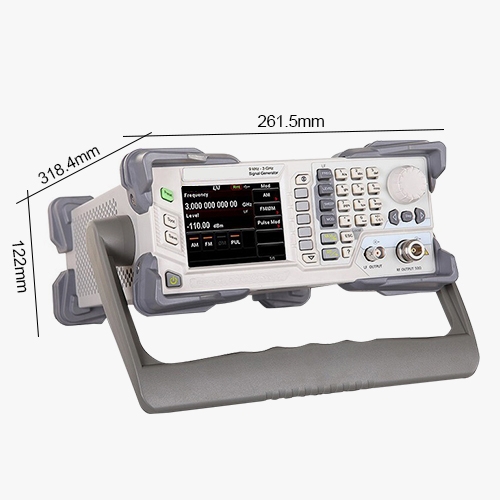
Digital RF Generator High Signal Purity
-
Excellent phase noise metrics. High signal purity, phase noise <-105dBc/Hz@20kHz typical, with optional high stability clock reference for even better near-side phase noise metrics.
-
High power output over a wide frequency band. max output amplitude up to +13dBm (nominal) can be set to +20dBm to meet the amplifier nonlinearity test.
-
Excellent amplitude accuracy. The amplitude accuracy of the output reaches 0.5 dB typical value, which can provide users with accurate excitation signals.
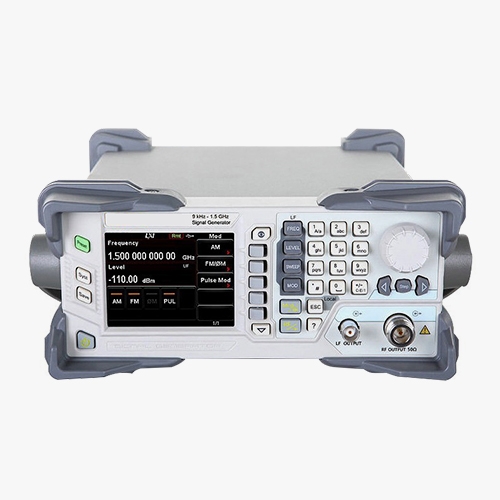
Highly Repeatable and Superior Pulse Modulation
-
Excellent repeatability provides engineers with sufficient test confidence, with less than 0.02 dB output amplitude change over 72 hours.
-
Good pulse modulation function. Generates high-quality pulse modulation signals with a typical rise/fall time of less than 10ns and an on/off ratio of more than 70 B. Supports both internal and external modulation. The built-in pulse generator can generate pulse sequences and output them externally as a standalone pulse generator.
Applications
The SISCO RF generator is a device used to generate radio waves for a wide range of applications in telecommunications, medical imaging, radar, broadcasting, semiconductors, military, education and consumer electronics. It is mainly used to test and calibrate various RF devices and systems to ensure their performance and quality, and also plays an important role in research and development.

Medical Imaging
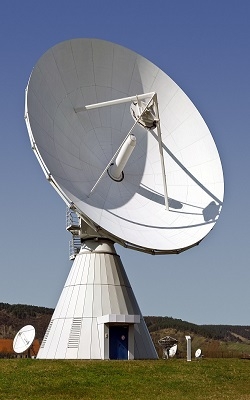
Radar Systems

Educational and Research

Telecommunications Testing
| Model | SISCO-RFG-DSG815 | |
| Frequency range | 9kHz~1.5GHz | |
| Amplitude indicator range | -110dBM to +13dBM | |
| Amplitude setting range | -110dBM to +20dBM | |
| Amplitude accuracy | <0.9dB (<0.5dB typical) | |
| Clock reference stability | <2ppm, <5ppb (with high stability clock reference option B08) | |
| Spectral purity | SSB phase noise | 100KHz≤f≤1.5GHz,<-100dBc/Hz(<-105dBc/Hz typical) 1.5GHz≤f≤3GHz, <-94dBc/Hz(<-99dBc/Hz typical) CW mode, carrier bias = 20KHz |
| Harmonic distortion | <-30dBc CW mode 1MHz≤f≤3GHz Output level≤+13dBm | |
| Non-harmonic distortion | 100KHz≤f≤1.5GHz, <-60dBc/Hz (<-70dBc/Hz typical) 1.5GHz≤f≤3GHz, <-54dBc/Hz (<-64dBc/Hz typical) |
|
| Scan | Scan mode | Linear scanning, step/list scanning single/continuous scanning |
| Scanning points | 2~65535 (step scan); 1-600 1 (list scan) | |
| Modulation type | AM, FM, PM, Pulse modulation | |
| AM | Modulation depth | 0%-100% |
| Modulation accuracy | <set value x4%+1% | |
| Modulation frequency response | 10Hz~10KHz(<3dBm,m<80%) | |
| FM | Max frequency bias | 125KHz-1MHz (nominal value, video segment range varies) |
| Modulation accuracy | <setting value x2%+20Hz | |
| Modulation frequency response | 10Hz 100KHz (<3dB) | |
| PM | Max frequency bias | 0.15625-20 rad (nominal value, video segment range varies) |
| Modulation accuracy | <set value x1%+0.1 rad | |
| Modulation frequency response | 10Hz-100KHz (<3dB) | |
| Pulse modulation | On/Off ratio | >70dB (100KHz<f≤3GHz) |
| Rise/fall time | <50ns, 10ns typical | |
| Pulse form | Single pulse, pulse train (option PUG-DSG800) | |
| General features | ||
| Interface settings | Standard: USB, LAN | |
| Front panel: RF output, internal modulation generator (LF) output | ||
| Rear panel: External trigger input signal, signal valid | ||
| Signal valid, pulse in/out | ||
| External modulation input ext mod, reference clock 10MHz ref in/out | ||
Details
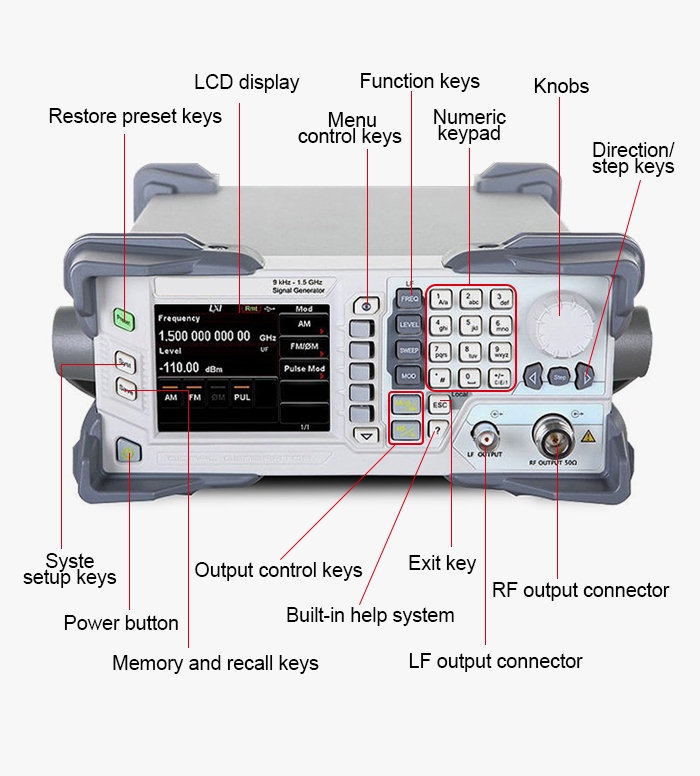
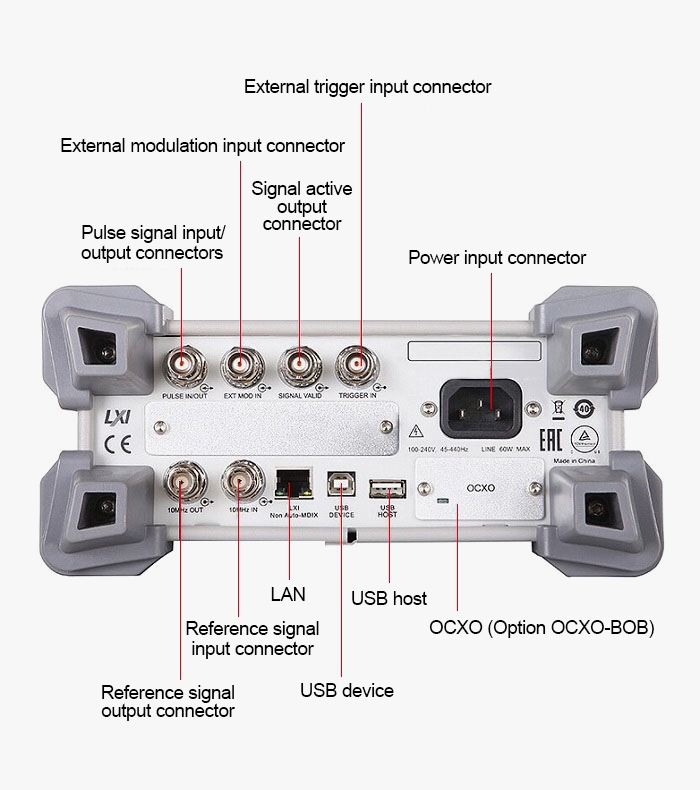
Q1: What is an RF generator?
A1: An RF generator (Radio Frequency generator) is a device that produces radio frequency signals, typically used for testing, research, and communication purposes. It generates specific frequencies and power levels to simulate or stimulate RF circuits, antennas, and other components in electronics and telecommunications.
Q2: How does an RF generator work?
A2: An RF generator produces radio frequency signals by generating oscillations at specific frequencies. It uses an oscillator circuit to create the signal, which can then be amplified and optionally modulated. The output signal is used for testing, communication, and other electronic applications.
Q3: What is the difference between AF and RF signal generators?
A3: The key difference between AF (Audio Frequency) and RF (Radio Frequency) signal generators lies in the frequency range they operate in:
- AF Signal Generator: Produces signals in the audio frequency range, typically from 20 Hz to 20 kHz. These signals are used in audio equipment testing, sound system calibration, and other applications involving audible frequencies.
- RF Signal Generator: Operates in the radio frequency range, which can vary from about 20 kHz to several GHz. These signals are used for testing and designing radio, communication systems, and other high-frequency electronic devices.
Tips: What is the frequency range of an RF generator?
The frequency range of an RF generator typically spans from around 10 kHz to several gigahertz (GHz), depending on the specific device and its application. Basic RF generators might cover a range from 10 kHz to a few hundred MHz, which is suitable for testing radio and communication equipment operating at lower frequencies.
More advanced RF generators, especially those used in modern telecommunications and wireless technology, can operate in the GHz range, often reaching up to 6 GHz or even higher, extending into the millimeter-wave frequencies (30 GHz and above) for specialized applications like radar and 5G testing. The exact frequency range depends on the model and purpose of the RF generator.
Thank you for buying industrial test and measurement equipment on SISCO.com, all products sold by SISCO and the partner cover a 12 months warranty, effective from the date of receiving the products.
What is covered?
SISCO is responsible for providing free spare parts, and free technical support to assist the customer to repair the defective products until the problem is solved.
What is not covered?
- Product purchased from anyone other than a SISCO store or a SISCO authorized reseller.
- Expendable parts.
- Routine cleaning or normal cosmetic and mechanical wear.
- Damage from misuse, abuse or neglect.
- Damage from use of parts other than SISCO approved.
- Damage from use outside the product’s usage or storage parameters.
- Damage from use of parts not sold by SISCO.
- Damage from modification or incorporation into other products.
- Damage from repair or replacement of warranted parts by a service provider other than a SISCO authorized service provider.
- Damage caused by the application environment not meeting the product usage requirements and the failure to perform preventive maintenance.

